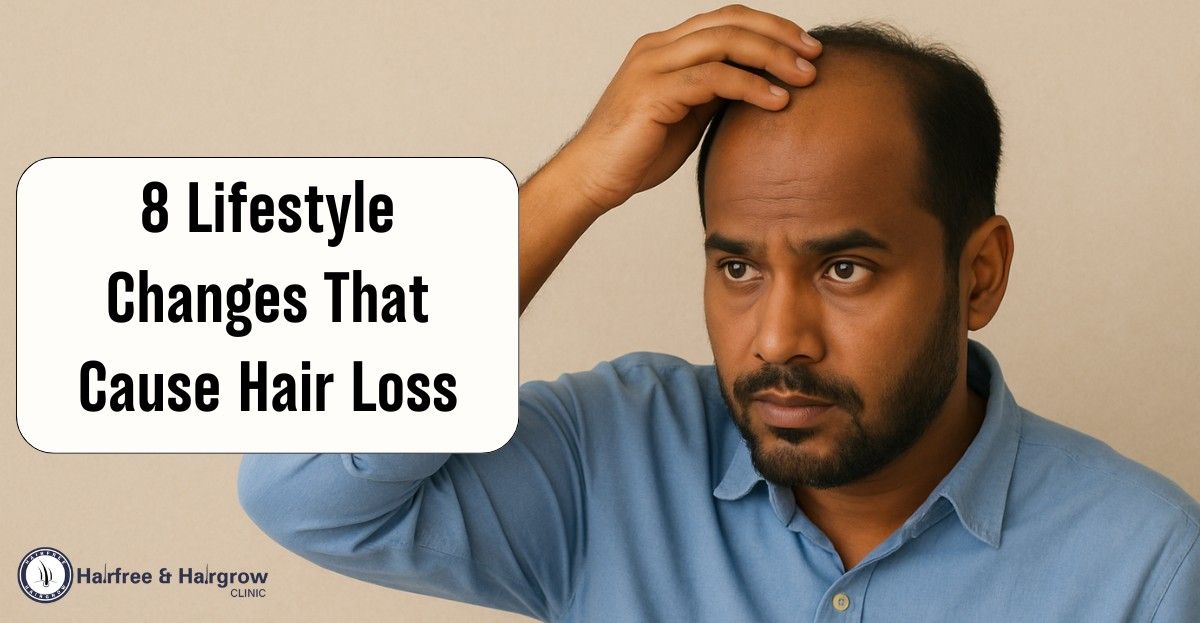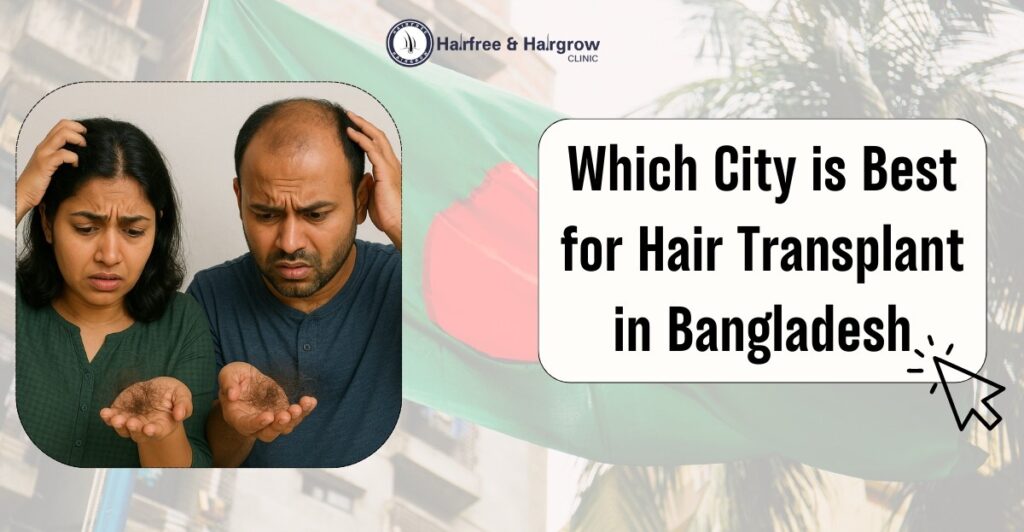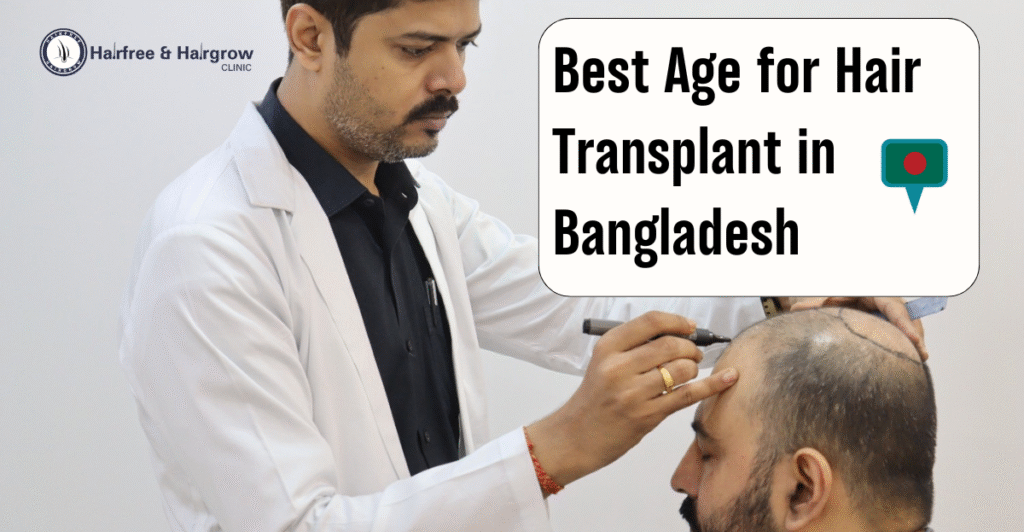Hair loss isn’t always driven by genetics alone. In today’s fast-paced world, everyday habits can significantly impact the health of your hair. Changes in diet, stress levels, sleep, and routine can trigger or worsen conditions like telogen effluvium, androgenic alopecia, and general hair thinning.
Let’s explore 8 scientifically backed lifestyle changes that commonly cause hair loss.
Table of Contents

1. Sudden Weight Loss, Crash Dieting and Skipping meals
When someone follows extreme calorie restriction, Skipping meals or rapid weight-loss diets, the body conserves nutrients for essential organs. As a result, the hair, which is non-essential for survival, suffers from protein malnutrition and lacks vital micronutrients like zinc, iron, and biotin.
A 2021 study in Dermatology Practical & Conceptual found that women experiencing telogen effluvium often had nutritional deficiencies linked to such diets.
Data Insight:
38% of patients with sudden hair loss showed zinc deficiency, and 21% had low ferritin, suggesting iron deficiency caused by diet.
2. Increased Stress and Anxiety
When the body is under prolonged stress, the stress hormone cortisol increases, which disrupts the natural hair growth cycle. Stress pushes hair follicles into the premature shedding or telogen phase, which results in significant thinning of hair.
The Journal of Clinical and Diagnostic Research found emotional stress to be a leading cause of sudden hair loss, often appearing 2–3 months after a stressful event.
Data Insight:
About 70% of people under chronic stress reported increased hair fall or visible scalp thinning.
3. Poor Sleep Patterns
Sleep is vital for regulating hormones and supporting cellular regeneration. During deep sleep, the body releases melatonin, which plays a key role in maintaining a healthy circadian rhythm and stimulating follicle health.
Research published in the International Journal of Trichology found that people with irregular sleep patterns or night-shift schedules had a higher chance of experiencing diffuse hair loss.
Data Insight:
Those who slept less than 6 hours per night were 1.8 times more likely to develop noticeable hair thinning.
4. Smoking and Tobacco Use
Smoking every day causes oxidative stress in the body and restricts blood circulation, which limits the supply of oxygen to your hair follicles. In addition, nicotine narrows blood vessels and accelerates the aging of hair follicles.
A study in the Archives of Dermatology showed that men who smoked regularly had a much higher risk of male pattern baldness.
Data Insight:
Among 740 men studied, 85% of smokers had moderate to severe hair loss compared to just 40% of non-smokers.
5. Overuse of Hair Styling Tools and Chemical treatments.
Frequent use of flat irons, curling rods, blow dryers, or hair straightening creams leads to keratin damage and follicular stress. This overexposure weakens the hair shaft and can even cause traction alopecia, especially when tight hairstyles are used.
A 2020 review noted that repeated chemical and heat treatments cause cumulative follicular damage, leading to brittle, thin hair and eventual hair loss.
Data Insight:
Excessive heat styling increased breakage risk by over 80%, and long-term users often experienced thinning at the temples and crown.
6. High-Sugar and Processed Foods
Diets high in processed sugar cause inflammation, spike insulin levels, and can lead to insulin resistance. This hormonal imbalance increases DHT (dihydrotestosterone), a byproduct of testosterone that is closely linked with androgenic alopecia.
A recent study published in BMJ Nutrition connected high glycemic index diets to premature hair thinning in young adults.
Data Insight:
People consuming over 100 grams of sugar daily had a 25% higher chance of developing early-stage hair loss.
7. Alcohol Consumption
Regular alcohol intake leads to vitamin B12, zinc, and folate depletion. These nutrients are essential for strong hair strands and maintaining a healthy scalp. Alcohol also disrupts hormonal balance and liver function, leading to reduced scalp hydration and increased follicular toxicity.
The American Journal of Clinical Nutrition found a strong link between long-term alcohol use and diffuse alopecia.
Data Insight:
Chronic alcohol users were three times more likely to suffer from nutritional hair loss, especially in the frontal and crown regions.
8. Lack of Physical Activity
A sedentary lifestyle can slow down blood circulation, reducing oxygen delivery to the scalp. Exercise enhances capillary flow and ensures that nutrients reach the follicles, which is essential for healthy hair growth.
According to Harvard Health Publishing, individuals with low physical activity levels show reduced microvascular performance, which directly affects scalp nourishment.
Data Insight:
Those who exercised fewer than two days per week experienced 60% more hair thinning compared to those who worked out at least 3 to 5 days weekly.
Conclusion
If you are experiencing hair fall, it may not just be your genetics. Factors like stress, poor nutrition, lack of sleep, smoking, and an inactive lifestyle play major roles. The good news is many of these are reversible. Addressing these root causes can lead to visible improvements in scalp health, hair density, and overall well-being.

Written By
Medical Officer & Hair Transplant Surgeon
Dr. Nazmin Sultana Nipa is a distinguished hair transplant doctor in Bangladesh, known for her advanced skills in hair restoration. As a Medical Officer and Hair Transplant Surgeon, Dr. Nipa combines her extensive experience in the field with a focus on transparency and patient-centered care.
Disclaimer
We’ve made all possible efforts to ensure that the information provided here is accurate, up-to-date and complete, however, it should not be treated as a substitute for professional medical advice, diagnosis or treatment. See Detailed Disclaimers Here.



